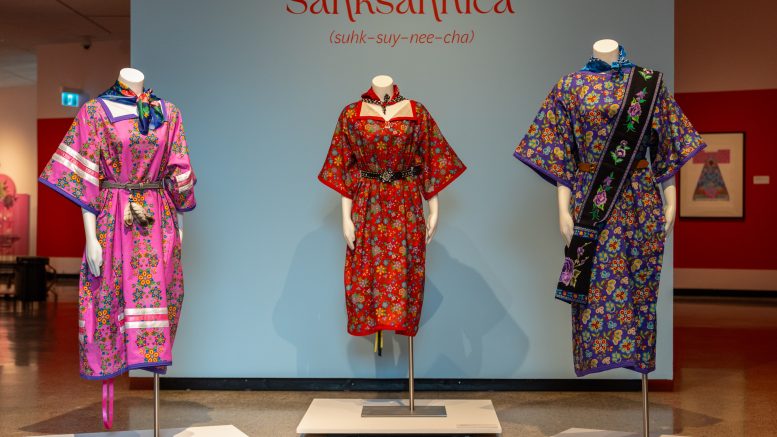Acclaimed multidisciplinary artist Lita Fontaine (Mikinaak Ikwe) premiered a long-awaited solo show at Winnipeg Art Gallery (WAG)-Qaumajuq earlier this month.
Fontaine is a 1997 graduate of the U of M’s school of art program and a founding member of Urban Shaman Gallery. Her first solo exhibition at the WAG, Without Reservation, was curated by Cathy Mattes in 2002. Fontaine has taught classes at the WAG Studio and recently retired as the artist-in-residence of Seven Oaks School Division.
Titling the new exhibit Winyan (the Dakota word for “woman”), the Dakota/Anishinaabe/Métis artist sought to celebrate Indigenous femininities as a source of beauty and a form of resistance to heteropatriarchal violence under colonialism.
The theme even extends to the colour of the walls. Exhibit curator Marie-Anne Redhead chose pastel pink precisely for its association with femininity. She observed that many people seem to identify themselves with either their affinity for or aversion to pink.
“Especially when women say, ‘I love pink,’” Redhead said, “it’s dismissed as frivolous” because of cultural connotations that mark women’s hobbies and aesthetic choices as “shallow [and] superficial.”
Redhead worked closely with Fontaine during the curation process. “You need to get to know the artist and to understand their practice,” as Redhead put it. A curator must also “respect [the artist] where they are now too, especially somebody like Lita who’s been practicing for so long.”
Fontaine’s wealth of artistic experience makes itself apparent as you walk through the gallery. The exhibit is full of bright and colourful works with floral, berry and medallion motifs. Many are circular in shape and nearly all have a pleasing symmetry.
“I grew up with the teachings and the Medicine Wheel around me,” Fontaine said, “so I’ve learned to understand balance,” adding that the circle has a particular significance in Indigenous culture because “it’s continuous, never-ending.”
In addition, buffalo skulls recur frequently in the artist’s work. For Fontaine, “the buffalo skull represents the Sun Dance […] It’s become one of my main motifs in my work [in which] it represents strength and hope and beauty.”
This came as an interesting revelation to me. My familiarity with the use of skulls in art comes primarily from European and Euro-Canadian traditions, where they often appear as a memento mori — a sombre reminder of death’s inevitability. For an immediate example of this, you can stroll down the hall into WAG-Qaumajuq’s ongoing Jean Paul Riopelle retrospective and glimpse one of his early-period still lifes titled “Nature bien morte.”
Although “nature morte” is the French expression for “still life,” the direct English translation is “dead nature.” Thus, in view of the skull placed in the foreground, Riopelle’s title can be read both as a pun and a meditation on death, but in Fontaine’s work, the skull appears to symbolize the exact opposite.
Perhaps surprisingly, Winyan is primarily a showcase of Fontaine’s newer pieces, many from 2023 onwards. She attributed her recent productivity to the COVID-19 pandemic. In early 2020, “a lot of things closed down […] I needed to do something, I needed to find strength […] so, as an artist, my medicine is making art.”
A major outlier in the exhibit, both in period and style, is “Mom Too,” a 1999-2000 collage that was also exhibited in her 2002 solo show. Much darker than the other pieces on display and an exception to Fontaine’s later move toward symmetry, Redhead nonetheless selected it because she “want[ed] her mother to be a presence in the show because so much of who she is as a person now is directly influenced by her mother.”
“Mom Too” contains an image of Bill C-31, federal legislation passed in 1985 to amend the Indian Act’s sexist provisions denying status to women who married non-status men. Fontaine’s social commentary continues to the present day with her latest iteration of “A Woman’s Drum” displaying a photograph of red dresses hanging outside Camp Marcedes.
The original installation was intended as a “reclamation of the drum,” which Dakota women were prohibited from playing in the aftermath of colonization. Now that this is no longer the case, Fontaine felt it was necessary to update the piece in tribute of Marcedes Myran, an Indigenous woman whose remains are widely believed to be in the Prairie Green landfill.
Despite the continuing struggle against male colonial violence, Fontaine stressed the importance of acknowledging Indigenous resilience and beauty.
“I don’t carry as much angst as I used to,” she said. “I wanted to […] deal with the beauty that I have within myself and bring it out. I don’t want to be stuck in that trauma.”
Lita Fontaine: Winyan is on display at WAG-Qaumajuq until January 12, 2025. Gallery hours are Wednesday through Sunday from 11 a.m. to 5 p.m.


